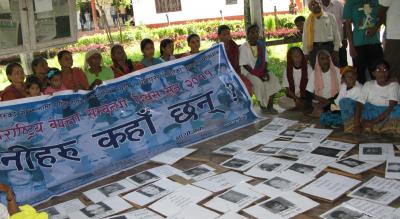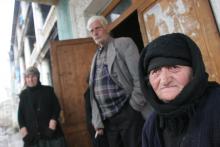Case prepared by Pierpaolo Castiglioni, Yiota Constantinidi, Fiammetta Ferioli, LL.M. students at Roma Tre University under the supervision of Giulio Bartolini (Professor) and Tommaso Natoli (Research assistant), Roma Tre University IHL Legal Clinic; with the contribution of Jemma Arman and Isabelle Gallino, LL.M. students at the Geneva Academy.
A. NEPAL: SUPREME COURT ORDERS ACTION ON ‘DISAPPEARANCES’
[...]
On June 1, the Supreme Court ruled on a large number of enforced disappearance cases, including 80 habeas corpus writs, and ordered the government to immediately investigate all allegations of enforced disappearances. The court ordered that this Commission of Inquiry must comply with international human [sic] standards.
[...]
Human Rights Watch and the International Commission of Jurists welcomed the comprehensive Supreme Court decision.
“Through this decision, Nepal’s Supreme Court has demonstrated the important role any judiciary can play in upholding respect for the rule of law and international human rights principles, even in a country just emerging from conflict,” said Wilder Tayler, deputy secretary-general of the International Commission of Jurists. “This decision should be a source of inspiration to other judiciaries in the world as they struggle to deal with cases involving enforced disappearances.”
The Supreme Court also ordered the government to prosecute those responsible for the death in custody of Chakra Bahadur Katuwal. Katuwal was transferred to army barracks following one day of detention in Okhaldhunga District police station. On the same day he was transferred to the army barracks he was returned to the police station showing severe signs of torture. He died later that day. When his family enquired about his whereabouts, they were told he had been transferred to another district.
The Supreme Court also ordered that while the investigations take place the government should take administrative action against members of the security forces under investigation for involvement in Katuwal’s death. The order requires the administrative action to be in line with the report of the Detainees Investigation Task Force formed by the Supreme Court, which recommended suspensions of those under investigation for enforced disappearances.
The court ordered the government to provide interim relief to the families of the victims of the “disappeared,” which is to be provided without any effect on the final outcome of these cases. The court also ordered the government to enact legislation that would criminalise enforced disappearances and take into account the new International Convention for the Protection of all Persons from Enforced Disappearance.
[...]
B. CONSTITUTIONAL PROTECTIONS UPHELD BY THE COURTS
a) Constitution
[...]
As noted, the human right to be free from arbitrary detention cannot be suspended during a declared state of emergency. With some exceptions, Nepal’s courts generally respected this right during the conflict via the mechanism of writ of habeas corpus. Preventive Detention Orders were challenged and many challenges were successful. Still, the Security Forces were less diligent with respect to this right and at times failed to honour a release order, or re-arrested a detainee whom the courts had released.
b) Preventive Detention Orders under the Public Security Act
The Public Security Act allowed Chief District Officers to issue a Preventive Detention Order for a period of 90 days, renewable for another 90 days, and finally renewable for a further 180 days (12 months in total).
[...]
The Public Security Act provided that Preventive Detention Orders issued pursuant to its provisions by a Chief District Officer could not be challenged in any court. However, the Constitutional articles cited above prevailed over that provision, and the legality of an arrest or Order could always be challenged in the Supreme Court or in the Appellate Courts.
[...]
10.4.8 Judiciary
The Supreme Court has played a significant role in human rights and IHL related cases. This was particularly the case in relation to habeas corpus petitions, pursuant to which the Court regularly ordered relevant security forces to present detainees in court during the conflict period. As mentioned above, the Supreme Court issued a landmark ruling on 83 habeas corpus writs in June 2007, and in so doing ordered the Government to set up a commission of inquiry to investigate allegations of disappearances in accordance with human rights standards (which at the time of writing has not been established). In May 2008, the Supreme Court also made a significant ruling that, in order to comply with its international legal obligations, the Government needed to enact a comprehensive law to address human rights violations resulting from the excessive use of force. The families of 22 victims sought assistance through mandamus writs from Appellate Courts and the Supreme Court in forcing the police to proceed with investigations. Nevertheless, there have been a number of serious obstacles to the court’s effectiveness and independence:
- Defiance of court orders by the police, army and the CPN (Maoist) severely undermined and continues to undermine the judiciary.
- Parallel justice systems operated during the conflict with each party to the conflict rejecting the legitimacy of the other’s courts. Where Maoist courts operated, individuals either preferred or were compelled to settle disputes in the “People’s court” rather than in the State’s judiciary.
- Several courts were destroyed during the conflict, including in Jumla, Jajarkot, Achham, Arghakhanchi, Myagdi and Bara Districts. All or part of the court records were also destroyed.
[...]
C. SUPREME COURT STRIKES DOWN AMNESTY PROVISION IN TRUTH AND RECONCILIATION LAW
(Mar. 17, 2015) On February 26, 2015, Nepal’s Supreme Court struck down the amnesty provision in the Truth and Reconciliation Commission (TRC) Act. [...]
The amnesty provision grants the Truth and Reconciliation Commission and the Commission on Enforced Disappearances the discretionary power to recommend amnesties for those responsible for grave violations or abuses of human rights. [...]
According to a Supreme Court official, “[t]he court has struck down the amnesty provision from the law and said the consent of the victims is necessary for any reconciliation.” [...]
The Court also “made it clear that cases that are sub judice at various courts cannot be transferred to the commissions.” Moreover, the Court “directed that the victim’s consent should be made mandatory for reconciliation.” [...]
The Supreme Court had already struck down as unconstitutional a 2013 ordinance that had established a TRC [...], partly on the basis that it provided for amnesties for persons responsible for serious human rights abuses. [...]
The current TRC Act was promulgated on May 11, 2014, through a compromise bill that was a revised version of the previous ordinance that the Court had struck down. However the new law retained the amnesty provisions. [...]
D. IS NEPAL FINALLY SERIOUS ABOUT FINDING ITS DISAPPEARED?
[...]
The political power struggle came to a head in 2014, when parliament adopted the Truth and Reconciliation Act. Much like the 2007 bill, this new act finally established CIEDP [Commission of Investigation on Enforced Disappeared Persons] anew, but also provided its partner body, the Truth and Reconciliation Commission (TRC), the ability to amnesty perpetrators. Such provisions were untenable to many victims, who were mistrustful of a commission with amnesty powers attached to it.
It seemed as though victim concerns would be allayed in early 2015, when the Nepal Supreme Court ruled the amnesty provisions in the Truth and Reconciliation Act unconstitutional. However, the government pushed the CIEDP forward without amending the law in response to the court’s ruling, simply carrying on with amnesty text in place.
Despite some attempts to amend the act, the amnesty provisions remain in place today. With the Supreme Court’s decision still unaddressed, parliament approved CIEDP’s regulations in March 2016 and set it to work.
[...]
“I have doubt that the commission will find the truth,” says Laxmi Khadka, whose husband was disappeared by Maoists. “I have heard that the government and commission are not following the Supreme Court decision, so how can they give voice to victims of the conflict?”
[...]
Discussion
I. Classification of the Situation and Applicable Law
1. How would you qualify the situation in Nepal between 1996 and 2006? What additional information would you require in order to make such a determination? (
GC I-IV, Art. 3;
P II, Art. 1)
II. Protections in Detention and Missing Persons
2. Does IHL provide a legal basis for detention in non-international armed conflicts? On what grounds may a person be detained? When must he or she be released? (
GC I-IV, Art. 3;
CIHL, Rule 128)
4. How does IHL seek to prevent that detainees become missing?
5. What obligations does IHL impose on parties with regards to missing persons? Does IHL provide an obligation to investigate “enforced disappearances”? (
CIHL, Rule 98;
117)
III. Elements Contributing to Respect for IHL
6. Do you think the rebuilding of courts should be a priority for States following times of armed conflicts? What role can courts have in ensuring compliance with IHL? What qualities must the judiciary have for it to effectively perform this role?
7. How did Nepal’s constitution facilitate the enforcement of IHL by its judiciary? In your opinion, should some IHL rules be included in a State’s constitution? If so, which rules?
8. How can a strong judiciary support civil society? In addition to the binding nature of judicial decisions, what “soft law” effect can they have?
10. Does IHL prohibit the granting of amnesties for war crimes? Do you believe there is a conflict between the values of ending impunity and building peace? Is an amnesty for war crimes admissible when the victims agree to it?






